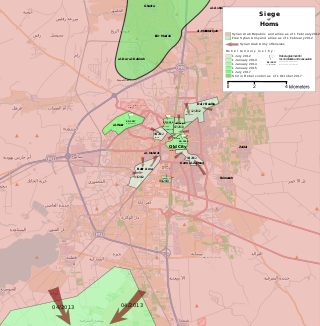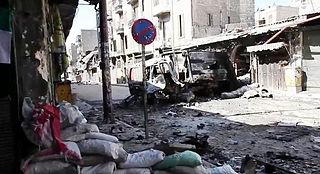The siege of Rastan and Talbiseh was an operation by the Syrian Army during the Syrian uprising. On 28 May 2011, after protests and armed revolt, the Syrian Army launched an operation in al-Rastan, a city of an estimated 50,000 residents 20 kilometers north of Homs, and the neighboring town of Talbiseh, which resulted in the suppression of the protests and numerous deaths. The Syrian Army met some armed opposition during the operation.

The Free Syrian Army (FSA) is a big-tent coalition of decentralized resistance militias in the Syrian Civil War founded on 29 July 2011 by Colonel Riad al-Assad and six officers who defected from the Syrian Armed Forces. The officers announced that the immediate priority of the Free Syrian Army is to safeguard the lives of protestors and civilians from the deadly crackdown by Bashar al-Assad's security apparatus; with the ultimate goal of accomplishing the objectives of the Syrian revolution, namely, the end to the decades-long reign of the ruling al-Assad family. In late 2011, the FSA was the main Syrian military defectors group. Initially a formal military organization at its founding, its original command structure dissipated by 2016, and the FSA identity has since been used by various Syrian opposition groups.

This is a broad timeline of the course of major events of the Syrian civil war. It only includes major territorial changes and attacks and does not include every event.
The following is a timeline of the Syrian uprising from September to December 2011. This period saw the uprising take on many of the characteristics of a civil war, according to several outside observers, including the United Nations Commission on Human Rights, as armed elements became better organized and began carrying out successful attacks in retaliation for the ongoing crackdown by the Syrian government on demonstrators and defectors.
Riad Mousa al-Asaad is a Syrian military commander, politician who is the founding leader of the Free Syrian Army. One of the prominent faces of the Syrian Revolution, he led the armed resistance to the Assad regime as commander-in-chief of FSA, during the early phase of the Syrian Civil War. Under Riad al-Asaad's command, FSA expanded into a para-military force of 75,000 guerillas and insurgents in March 2012; capable of ousting regime forces from Damascus. He currently serves as the Deputy Prime Minister for Military Affairs of the Syrian Salvation Government, a position he has held since 2 November 2017. He was a former Colonel in the Syrian Air Force who defected to the opposition in July 2011 and became the first Acting Commander-in-chief of the Free Syrian Army.

The siege of Homs was a military confrontation between the Syrian military and the Syrian opposition in the city of Homs, a major rebel stronghold during the Syrian Civil War. The siege lasted three years from May 2011 to May 2014, and resulted in an opposition withdrawal from the city.

The 2011–2013 Daraa Governorate clashes are a series of military confrontations between the Syrian Army and the Free Syrian Army in Daraa Governorate, Syria, which began in November 2011, after widescale protests and crackdown on protesters in Daraa had lasted since April 2011. The clashes had been ongoing as part of the Syrian civil war, until the U.N. brokered cease fire came into effect on 14 April 2012. Sporadic clashes continued since then, however.
The Rif Dimashq clashes were a series of unrests and armed clashes in and around Damascus, the capital of Syria, from November 2011 until a stalemate in March 2012. The violence was part of the wider early insurgency phase of the Syrian Civil War. Large pro-government and anti-government protests took place in the suburbs and center of Damascus, with the situation escalating when members of the Free Syrian Army (FSA) started attacking military targets in November.

The September 2011 – March 2012 Idlib Governorate clashes were the violent incidents that took place in Idlib Governorate, a province of Syria, from September 2011 and prior to the April 2012 Idlib Governorate Operation.
A battle for control of Rastan, a city of 60,000 residents in Homs Governorate, Syria, occurred from 27 September to 1 October 2011. In late September, there were reports of numerous Syrian Army defections in the area, following which the Free Syrian Army took control of Rastan. After a four-day battle, the city was retaken by the Syrian Army.
The following is a timeline of the Syrian Civil War from January to April 2012, during which time the spate of protests that began in January 2011 lasted into another calendar year. An Arab League monitoring mission ended in failure as Syrian troops and anti-government militants continued to do battle across the country and the Syrian government prevented foreign observers from touring active battlefields, including besieged opposition strongholds. A United Nations-backed ceasefire brokered by special envoy Kofi Annan met a similar fate, with unarmed UN peacekeepers' movements tightly controlled by the government and fighting.
The Battle of Zabadani took place in January through February 2012, during the Syrian Civil War. During the initial stages of the battle, the rebel FSA took control of the town. However, less than a month later, the Army retook control of Zabadani, forcing rebel fighters to withdraw towards the Lebanese border.

The Battle of Idlib was a battle that was fought in the city of Idlib, located in the north of Syria, starting on 10 March 2012. The battle took place in a province considered a stronghold of the armed opposition to the Syrian government and was fought in the wider context of the Syrian Army trying to retake several rebel strongholds. After three days of fighting, the Syrian Army recaptured the city.
The Hama Governorate clashes were a series of incidents of fighting during late 2011 and early 2012 in the Syrian Governorate of Hama, as part of the Early insurgency phase of the Syrian Civil War.
The following is a timeline of the Syrian Civil War from May to August 2012. The majority of death tolls reported for each day comes from the Local Coordination Committees, an opposition activist group based in Syria, and the Syrian Observatory for Human Rights, another opposition group based in London.

Darat Izza is a town in northern Syria, administratively part of the Aleppo Governorate, located 30 kilometres northwest of Aleppo. Nearby localities include Deir Samaan to the north, Anadan to the east and Turmanin to the southwest.

The siege of Wadi Deif refers to the siege of two Syrian Army bases, Wadi Deif and Hamadiyah, by rebel forces, starting on 11 October 2012, during the Idlib Governorate clashes of the Syrian civil war.

The June 2012–April 2013 Idlib Governorate clashes was a series of clashes within the scope of the Syrian civil war, that took place in Syria's Idlib Governorate. The events followed the April 2012 Idlib Governorate Operation by the Syrian government and consequent cease-fire attempt, which had lasted from 14 April to 2 June 2012.
The following is a timeline of the Syrian Civil War from January to July 2015. Information about aggregated casualty counts is found at Casualties of the Syrian Civil War.

The 2012–2013 escalation of the Syrian Civil War refers to the third phase of the Syrian Civil War, which gradually escalated from a UN-mediated cease fire attempt during April–May 2012 and deteriorated into radical violence, escalating the conflict level to a full-fledged civil war.












